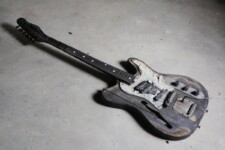Why Guitars Can Sound Out Of Tune Up The Neck (Answered)
It’s frustrating when your guitar sounds fine playing notes or chords at one place on the neck, but the tuning sounds off at another place further up or down the neck.
When you’ve spent time carefully tuning your guitar and it just doesn’t sound right when you start playing it can be really frustrating. You might have used an electronic tuner, and they can’t be wrong …can they?
It’s common for cheaper guitars to sound out of tune at certain places on the fretboard, but can also happen with older guitars. Some reasons this can happen are:
- Uneven fret height.
- Worn crowns on the frets.
- A warped neck.
- Too much neck relief.
- Intonation.
- Action.
We’re going to take a closer look at each type of problem you’re likely to encounter, and briefly discuss how to find solutions.

Why New Guitars Can Sound Out Of Tune Up The Neck
These days there are any number of cheap guitars and surprisingly many are very good value for money, having hardware that will generally do the job and an instrument that sounds pretty good.
In days gone by this wasn’t always the case, as a cheapo guitar 30 years ago was really just …a cheap guitar! They often didn’t sound so great and had poor quality hardware.
Given that new cheap guitars often have an acceptable build standard and hardware, why do many still sound out of tune in various places on the fretboard?
The main cost saving for guitar manufacturers is the time spent making the guitars.
Things like adjusting the nut correctly, checking frets for flatness up the neck, setting the bridge height, and setting the intonation are rushed so that they can afford to sell you a guitar at a cheaper price.
All these areas contribute to a guitar sounding out of tune and is usually more noticeable low down the fretboard near the tuners.
This doesn’t mean the guitar is bad, it just means it needs a little work to correct the problems, and you can end up with a great sounding guitar with just a few tweaks.
Why Your Guitar Is Out Of Tune On Higher Frets
More commonly than not, if your guitar sounds in tune at frets 1 – 3 but sounds out of tune up toward the 12th fret, this is the intonation.
Guitars by design will never be perfectly in tune for every string in every fret position on the neck, so everything is a small compromise to give the closest tuning possible.
This topic is quite detailed, and rather than write pages about it, check out the video below where Paul Davids explains this in laymans terms:
But before you check the intonation you should first look at the string height at the 12th fret, this is known as the ‘action’ and if the action is too high this can cause intonation issues.
You can adjust intonation with a good tuner, and current mobile phone apps can work very well. Check out this article discussing phone tuner apps.
- If the action is far too high, then the strings become stretched when you press down with your fingers to make them contact the frets, and a stretched string will sound sharp.
A normal action for electric guitars is around 1/16″ (1.6mm) on the high E string and 3/32″ (2.4mm) on the low E string. On an acoustic it is around 5/64″ (2.0mm) on the high E string and 7/64″ (2.8mm) on the low E string.
It doesn’t matter too much if the action is 1mm above this and would mainly affect the guitars playability more than the intonation. An extremely high action just makes a guitar hard to play.
Changing the action can be done by adjusting the bridge height, and also adjusting the truss rod in the neck if the neck is bowed upward too far.
When you have checked and adjusted the action you then need to check the tuning at the 12th fret for each string, and this will set the intonation correctly.
The method for adjusting this is different for various bridges on electric guitars, and for most acoustic guitars is automatically set by the bridge saddle – commonly being compensated saddles.
Why Is My Guitar Out Of Tune On Lower Frets?
1. Your Playing Level or Style
It’s common with beginners to press the strings too hard, and also to bend them slightly when learning to play chords, and this can be even worse on an electric guitar since the strings are thinner than acoustic.
This causes the notes to be out of tune since the string is stretched slightly each time excessive pressure is used, making the notes sound sharp.
Although this happens to a small degree further up the neck, it is most noticeable in frets 1-3.
2. The Nut
The nut on a guitar is the piece at the bottom of the neck with slots and holds the strings in position on their way to the tuners.
Quite often the slots are not deep enough, and make the strings sit too high off the frets, meaning you’ll have to bend the strings too far to touch the frets – and yes, you’ll get sharp notes!
A general way to check for correct string height at the nut is to hold the string down lightly on the 2nd fret, and there should only be enough gap between the string and 1st fret to slip a thick piece of paper through.
If this is too high, then it best to get a luthier to adjust this for you unless you have experience.
You can also experience binding of strings if the nut slots are too narrow, and this can affect tuning and keeping the guitar in tune when playing, especially if you do a lot of bends.
With either of these two issues you will usually find that playing A or D chords in the open position sound horrible, no matter how long you spend tuning your guitar.
Fret Wear And Intonation Issues
If you have played your guitar loads or have an older guitar it’s likely that the frets will have worn down in places.
This is normal over time as the strings are made of metal and the constant pressure slowly wears the top surface of the frets.
This eventually causes intonation problems with the guitar sounding in tune on some frets but not on others.
When a fret is in good condition it will have a rounded shape with the crown at an even height across the top of the fret.
As frets wear away, they develop flat spots and grooves on the top, and the point of contact changes from the crown in the center of the fret to the outside edge of the fret.
The point of contact doesn’t change much, but is enough for your ear to hear the difference.
If frets are too far worn your guitar may need re-fretting, or otherwise will need the frets leveled and re-crowned.
If your frets look like the photograph, then it’s time to get a luthier to look at your guitar, or if you’re brave you could learn to do this yourself.
Is it normal for new guitar strings to go out of tune?
Changed your strings lately?
When you are playing higher up the neck and doing string bends you might find that your guitar is out of tune fairly quickly.
If you haven’t correctly locked the strings around the tuning posts and the strings still need to be stretched in properly, you will constantly find you need to re-tune.
- New strings have a lot of slack in them, and a good stretching routine before playing them the first time will help keep your tuning constant.
Can Old Strings Sound Out of Tune?
Old strings after much playing build up oil and dirt in the windings, and also get worn down where they contact the frets.
These variations along the length of the string mean it might not oscillate (vibrate) evenly along its length, and can sound sharp or flat depending on which section of the string is being played.
They sound very muddy, and you can never quite get old strings to sound in tune up and down the neck.
Intonating strings correctly requires them to be in reasonably good condition (no rusty strings!).
Why Does My Capo Sound Weird Up The Neck?
Many cheaper capos don’t have a way to change the pressure that they push down on the strings with.
If a capo exerts too much pressure on the strings it can cause them to stretch over the fret and everything you play higher up the fretboard will sound out of tune.
When you shop for a capo make sure the one you choose has an adjustment feature to set the pressure just high enough that the strings don’t rattle or sound muted when played.
The Wrap Up
That should cover most reasons why your guitar would sound out of tune at different places on the guitar neck, and point you in the right direction to sort your problem out.
Some problems are easy to fix yourself like adjusting the truss rod, setting the intonation at the bridge, and fitting new strings – so watch some videos and try for yourself.
If the problem is deeper like worn frets, problem with the nut, or bridge too high on an acoustic guitar – then head into a reputable guitar shop and get a luthier to correct it.



